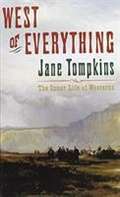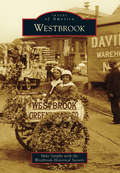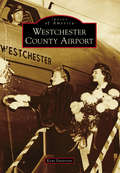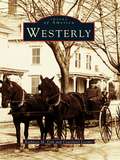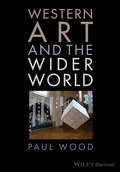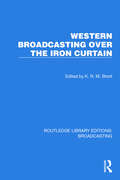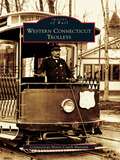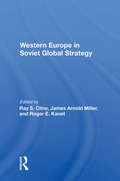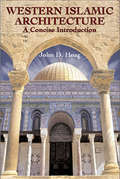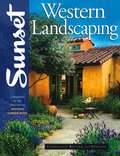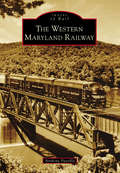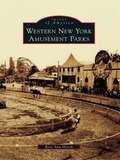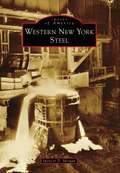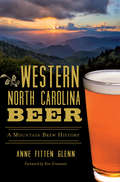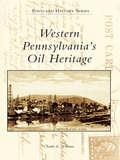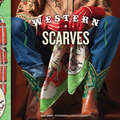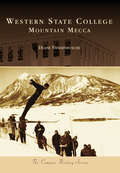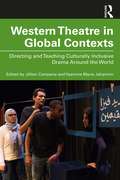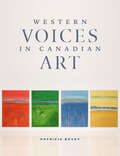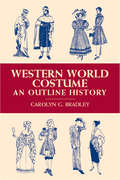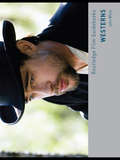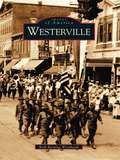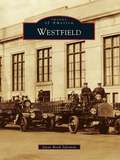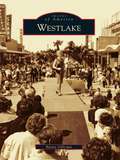- Table View
- List View
West of Everything: The Inner Life of Westerns
by Jane P. TompkinsA leading figure in the debate over the literary canon, Jane Tompkins was one of the first to point to the ongoing relevance of popular women's fiction in the 19th century, long overlooked or scorned by literary critics. Now, in West of Everything, Tompkins shows how popular novels and films of the American west have shaped the emotional lives of people in our time. Into this world full of violence and manly courage, the world of John Wayne and Louis L'Amour, Tompkins takes her readers, letting them feel what the hero feels, endure what he endures. Writing with sympathy, insight, and respect, she probes the main elements of the Western--its preoccupation with death, its barren landscapes, galloping horses, hard-bitten men and marginalized women--revealing the view of reality and code of behavior these features contain. She considers the Western hero's attraction to pain, his fear of women and language, his desire to dominate the environment--and to merge with it. In fact, Tompkins argues, for better or worse Westerns have taught us all--men especially--how to behave. It was as a reaction against popular women's novels and women's invasion of the public sphere that Westerns originated, Tompkins maintains. With Westerns, men were reclaiming cultural territory, countering the inwardness, spirituality, and domesticity of the sentimental writers, with a rough and tumble, secular, man-centered world. Tompkins brings these insights to bear in considering film classics such as Red River and Lonely Are the Brave, and novels such as Louis L'Amour's Last of the Breed and Owen Wister's The Virginian. In one of the most moving chapters (chosen for BestAmerican Essays of 1991), Ttompkins shows how the life of Buffalo Bill Cody, killer of Native Americans and charismatic star of the Wild West show, evokes the contradictory feelings which the Western typically elicits--horror and fascination with violence, but also love and respect for the romantic ideal of the cowboy. Whether interpreting a photograph of John Wayne of meditating on the slaughter of cattle, Jane Tompkins writes with humor, compassion, and a provocative intellect. Her book will appeak to many Americans who read or watch Westerns, and to all those interested in a serious approach to popular culture.
Westbrook (Images of America)
by Mike Sanphy Westbrook Historical SocietyThe town of Westbrook, Maine, was incorporated in 1814 while under the jurisdiction of the Commonwealth of Massachusetts and was voted to become a city in 1891. Settlers were first drawn to the area for its prime location along the Presumpscot River as they harvested lumber and built sawmills and gristmills. The Cumberland & Oxford Canal, built by Irish laborers, ran along the river through wooded areas, ponds and lakes, and neighboring towns. It served as a major transportation route until the development of railroads. Rail enabled Westbrook to become an industrial center, attracting many skilled workers. Several mills, such as Westbrook Manufacturing, Haskell Silk Mill, S.D. Warren Paper Mill, and Dana Warp Mill, exported their goods across the globe. While dairy farms once populated the town's landscape, only a few are left standing, most notably Smiling Hill Farm. Today, Westbrook, diverse in population, features fine restaurants and a growing music and art community.
Westchester County Airport (Images of America)
by Kent PattersonWestchester County Airport is referred to by the International Air Transport Association as HPN or, more endearingly by its patrons, White Plains Airport. The airport is unique in that it has the feel of a rural or regional airport but is within the New York metro area. Today, the airport bustles with traffic, accommodating commercial airlines, business, and private aviation. The golden age of aviation gave way to a major industry with the employment of modern airports featuring lighted concrete runways and new technologies like radio. In Westchester County, this all began with a seaplane operation at Rye-Cove in the early 1920s, followed by the call for a county airport in 1928, but it did not come to fruition until 1945. World War II generated a need for an airfield at Rye Lake, and by 1945, diminished defense needs permitted the transition from military airfield to county airport.
Westerly (Images of America)
by Kathleen M. Fink Courtland LoomisThese images take us on a journey into the past. We see pictures of local buildings and businesses, many of which no longer exist but are still warmly remembered by native citizens, and we also see the many stages of development, including street widening and drainage, which have revolutionized life for local people over the decades. Other photographs show how much transport in particular has changed, as we see the great sailing vessels of the early nineteenth century and early modes of transport such as horses and carriages and open trolleys. From livery stables in the 1800s we are transported to the era of the automobile with pictures of Hoxsie Plymouth Dodge in the early 1900s and early autos from the 1920s and 1930s. There are images of the famous local Smith quarries, showinggranite employees at work and the oxen-drawn carts used at that time. Taken over many decades, the photographs collected here bring home just how much the town has changed over the years. We experience bad times as well as good as we witness the many fires which have so drastically changed the landscape of Westerly and also the harsh years of the 1930s when the area was devastated by the Great Depression. Most important of all, we encounter the local people of Westerly, at work and at play over the decades, including school groups, sports teams, fraternities, and individual portraits of the men, women, and children who have created Westerly's history. Combining fascinating old photographs and concise, yet informative, text, this compelling visual history will delight young and old, resident and visitor alike.
Western Art and the Wider World
by Paul WoodWestern Art and the Wider World explores the evolving relationship between the Western canon of art, as it has developed since the Renaissance, and the art and culture of the Islamic world, the Far East, Australasia, Africa and the Americas. Explores the origins, influences, and evolving relationship between the Western canon of art as it has developed since the Renaissance and the art and culture of the Islamic world, the Far East, Australasia, Africa and the Americas Makes the case for ‘world art’ long before the fashion of globalization Charts connections between areas of study in art that long were considered in isolation, such as the Renaissance encounter with the Ottoman Empire, the influence of Japanese art on the 19th-century French avant-garde and of African art on early modernism, as well as debates about the relation of ‘contemporary art’ to the past. Written by a well-known art historian and co-editor of the landmark Art in Theory volumes
Western Broadcasting over the Iron Curtain (Routledge Library Editions: Broadcasting #38)
by K.R.M. ShortWestern Broadcasting Over the Iron Curtain (1986) examines the development of broadcasting policy by Western democracies, levels of government control of policy, efforts by communist regimes to minimize the effects of western broadcasting, and Soviet and Eastern European audience opinions on such diverse subjects as the success or failure of socialism and the Korean airline disaster.
Western Connecticut Trolleys (Images of Rail)
by Connecticut Motor Coach MuseumThroughout history, Americans have embraced technology with a special enthusiasm, and the innovation of the trolley car is no exception. This industry fueled the growth of many towns and cities in Connecticut, and Western Connecticut was able to keep pace with other parts of the state because of it. Although short lived, the trolley changed the landscape of the state and spurred progress in ways never imagined just a few years before. Marking an important milestone in the documentation of Connecticut's street railway heritage, Western Connecticut Trolleys is the sixth Arcadia Publishing book chronicling the history of all the streetcar lines and companies in the state.
Western Europe In Soviet Global Strategy
by Ray S. ClineSoviet global strategy, long established and well understood by the Kremlin leaders, is to intimidate weak and fearful governments, exploit indigenous difficulties, disrupt social order, and promote communist revolutions. In this volume, European and American scholars describe the USSR's land and sea targets on and surrounding West Europe, where t
Western Islamic Architecture: A Concise Introduction (Dover Architecture)
by John HoagAmong the glories of world architecture, Islamic mosques and palaces — from Spain to Egypt and other parts of the Middle East — are universally studied and admired. This profusely illustrated introduction to that subject gives a lively account of the style of structures symbolized by domed mosques, mosaic-lined arcades, and filigreed interiors.A brief, scholarly essay, followed by drawings, maps, and photographs of excellent quality, contrasts — among other buildings — the airy internal ornamentation and almost elegant sensuality of Spain's Alhambra with the austerity of Egypt's Mosque of Ibn Tulun, both of which, in turn, are compared to the monumental Ottoman mosques built in Turkey.One of the most useful reference tools for studying architecture of the Islamic world, this "remarkably lucid survey … will be particularly valuable in high school and college libraries." — Best Sellers.
Western Landscaping: Companion to the Best-selling Western Garden Book
by Sunset Publishing Staff Kathleen Norris BrenzelThis all-new second edition, the companion book to the much-beloved Western Garden Book, promises to be just as successful as the first. Packed with expert advice from landscape designers, gardeners, and others, it addresses climatic, soil, and topographical challenge sand solutions for Arizona, California, Colorado, Idaho, Montana, Nevada, New Mexico, Oregon, Utah, Washington, Wyoming, and southwestern Canada. Features n The only landscaping guide designed specifically for Western gardeners n Over 600 photographs and dozens of ready-to-use landscape plans n Step-by-step illustrations and exploded views show easy, do-it-yourself solutions n Seasonal gardening guides and checklists ensure year-round success for experienced and novice gardeners alike n Easy-to-understand plant selection and growing instructions
Western Maryland Railway, The (Images of Rail)
by Anthony PuzzillaThe Western Maryland Railway was never a large Class 1 rail carrier, but during its 131 colorful years of existence, it provided extremely fast, efficient, and reliable freight; coal-hauling; and passenger service in the states it served. This book contains images from the history of this remarkable railroad and also provides the reader the opportunity to see how the legacy of the Western Maryland Railway is being maintained and remembered even today at some of its well-known train stations, such as in Cumberland and Union Bridge, Maryland, now home to the Western Maryland Railway Historical Society (WMRHS). The Western Maryland is now gone, but through the wonderful images captured and preserved by the WMRHS and private archival photograph collections, the dream of the railway will live on.
Western New York Amusement Parks (Images of America)
by Rose Ann HirschFor more than 100 years, western New Yorkers have enjoyed the region's exciting amusement parks. During the days of trolleys and steamships, area businessmen created Celoron Park, Crystal Beach Park, and other fine local summer resorts. Decades later, lifelong memories were formed for neighborhood baby boomers who visited Glen Park and Fantasy Island, as well as one of New York State's finest theme parks, Darien Lake. Western New York has always been a proving ground for some of the nation's most famous roller coasters. The terrifying Cyclone, the fast and furious Silver Comet, and the extreme Ride of Steel have attracted the very bravest of visitors. In the new millennium, the summer tradition of visiting local amusement parks continues with a blend of family-orientated parks and theme parks that appeal to all ages.
Western New York Steel
by Spencer D. MorganOver the past 200 years, Western New York has been witness to the socioeconomic rise and decline of a mighty steel industry. Like other rust belt cities, Buffalo, New York, was once an incredible financial and manufacturing superpower on the Great Lakes. The steel industry of Western New York was a leader of the Gilded Age and the embodiment of the postwar American dream. It employed almost a third of the regional population--many of whom still live in the area. As time progressed, failure to develop and compete with foreign contenders ultimately led to the collapse of its steel industry. Former steel workers have fought to keep this regional history alive and have contributed to this book. The Steel Plant Museum of Western New York, along with members of the community, have graciously assisted in the selection of images used to describe this once-great and influential industry.
Western North Carolina Beer: A Mountain Brew History (American Palate)
by Ken Grossman Anne Fitten GlennOver the past two hundred years, Western North Carolina has evolved from a mountainous frontier known for illicit moonshine production into a renowned destination for craft beer. Follow its story from the wild days of saloons and the first breweries of the 1870s through one of the longest Prohibitions in the nation. Eventually, a few bold entrepreneurs started the first modern breweries in Asheville, and formerly dry towns and counties throughout the region started to embrace the industry. The business of beer attracts jobs, tourists and dollars, as well as mixed emotions, legal conundrums and entrepreneurial challenges. Join award-winning beer writer Anne Fitten Glenn as she narrates the storied history of brewing in Western North Carolina.
Western Pennsylvania's Oil Heritage (Postcard History Series)
by Charles E. WilliamsThe discovery of oil flowing from a well in the wilds of northwestern Pennsylvania shook the modern world in 1859. Refined as kerosene for lamps, a lubricant for home and industrial needs, and ultimately as a fuel for transportation in the form of gasoline, oil literally changed the world and defined global economics and politics. Western Pennsylvania's Oil Heritage profiles the history of Pennsylvania oil from its discovery and development to its impact on the culture, economy, and environment of the oil region. These vintage postcards provide a glimpse into the wide-ranging history of western Pennsylvania's oil region, from the cradle of the industry at Oil Creek, to the immensely productive Bradford oil field, and on to cities and towns like Oil City, built largely by the black gold.
Western Scarves
by Diane ZamostA photo-filled look at the cowboy accessory that&’s become a modern work of art and fashion statement. No longer just a rag to wipe the sweat and dirt off a cowboy&’s face, western scarves have become a work of art. From hipsters to rock stars, this &“wild rag&” is a unique fashion statement. With beautiful photography, Diane Zamost, an expert in western clothing who&’s spent over twenty years buying and selling at horse shows, rodeos, and western arts festivals, takes the reader through the history of the scarf, its uses, and creative ways to tie it. Celebrate cowboy couture at its finest!
Western State College: Mountain Mecca
by Duane VandenbuscheWestern State College is located on Colorado's Western Slope, deep in the Rocky Mountains. It began as Colorado State Normal School, which was a two-year institution in 1911. Twelve years later, Colorado Normal became a four-year school--Western State College. Sitting at an altitude of 7,723 feet, it is the highest college or university in the nation. The elevation, the Rocky Mountains, two nearby ski areas, world-class mountain bike trails, stunning scenery, and the nearby Blue Mesa Reservoir (which is Colorado's second-largest tourist attraction) all combine to make Western State College an outdoor mecca, attracting students from all over the nation.
Western Theatre in Global Contexts: Directing and Teaching Culturally Inclusive Drama Around the World
by Yasmine Jahanmir Jillian CampanaWestern Theatre in Global Contexts explores the junctures, tensions, and discoveries that occur when teaching Western theatrical practices or directing English-language plays in countries that do not share Western theatre histories or in which English is the non-dominant language. This edited volume examines pedagogical discoveries and teaching methods, how to produce specific plays and musicals, and how students who explore Western practices in non-Western places contribute to the art form. Offering on-the-ground perspectives of teaching and working outside of North American and Europe, the book analyzes the importance of paying attention to the local context when developing theatrical practice and education. It also explores how educators and artists who make deep connections in the local culture can facilitate ethical accessibility to Western models of performance for students, practitioners and audiences. Western Theatre in Global Contexts is an excellent resource for scholars, artists, and teachers that are working abroad or on intercultural projects in theatre, education and the arts.
Western Voices in Canadian Art
by Patricia BoveyThe story of artists in Western Canada, and how they changed the face of Canadian art “Listen to the visual voices of artists. They tell us so poignantly who we are, what we must cherish, and what we must address as a society.” Patricia Bovey Throughout her remarkable career as a gallery director, curator, and author, Patricia Bovey has tirelessly championed the work of Western Canadian artists. Western Voices in Canadian Art brings this lifelong passion to a crescendo, delivering the most ambitious survey of Western Canadian Art to date. Beginning with the earliest European-trained artists in Western Canada, and moving up to present day, Bovey amplifies the depth, scope, and importance of the diverse artists (both settler and Indigenous) whose distinct voices have contributed to the Western Canadian artistic tradition. Bovey then adopts a thematic approach, richly informed by her knowledge and experience, connecting art and artists through time and across provincial boundaries. Insights from Bovey’s studio visits and conversations with artists enhance our understandings of the history and trajectory of, and impetus for Canadian artistic creation. Lavishly illustrated with over 250 works reproduced in full colour, Western Voices in Canadian Art is a book that needs to be seen, and its artists and art celebrated.
Western World Costume: An Outline History (Dover Pictorial Archive Ser.)
by Carolyn G. BradleyFrom prehistory to the mid-20th century, this informative book describes and illustrates the development of Western dress. The text — enhanced by nearly 500 illustrations — appears in outline form, permitting easy cross-referencing of material. Details of distinctive features for each era include footwear, headgear, accessories, and typical colors and materials. 491 black-and-white illustrations.
Westerns: The Essential 'Journal of Popular Film and Television' Collection
by Gary R. Edgerton Michael T. MarsdenFor nearly two centuries, Americans have embraced the Western like no other artistic genre. Creators and consumers alike have utilized this story form in literature, painting, film, radio and television to explore questions of national identity and purpose. Westerns: The Essential Collection comprises the Journal of Popular Film and Television’s rich and longstanding legacy of scholarship on Westerns with a new special issue devoted exclusively to the genre. This collection examines and analyzes the evolution and significance of the screen Western from its earliest beginnings to its current global reach and relevance in the 21st century. Westerns: The Essential Collection addresses the rise, fall and durability of the genre, and examines its preoccupation with multicultural matters in its organizational structure. Containing eighteen essays published between 1972 and 2011, this seminal work is divided into six sections covering Silent Westerns, Classic Westerns, Race and Westerns, Gender and Westerns, Revisionist Westerns and Westerns in Global Context. A wide range of international contributors offer original critical perspectives on the intricate relationship between American culture and Western films and television series. Westerns: The Essential Collection places the genre squarely within the broader aesthetic, socio-historical, cultural and political dimensions of life in the United States as well as internationally, where the Western has been reinvigorated and reinvented many times. This groundbreaking anthology illustrates how Western films and television series have been used to define the present and discover the future by looking backwards at America’s imagined past.
Westerns: The Institutes Of Architecture Of Western Australia (Routledge Film Guidebooks #1)
by John WhiteIt is a common assertion that the history of America is written in its Westerns, but how true is this? In this guidebook John White discusses the evolution of the Western through history and looks at theoretical and critical approaches to Westerns such as genre analysis, semiotics, representation, ideology, discourse analysis, narrative, realism, auteur and star theory, psychoanalytical theory, postmodernism and audience response. The book includes case studies of 8 key westerns: Stagecoach My Darling Clementine Shane The Good, The Bad and the Ugly McCabe and Mrs Miller Unforgiven Brokeback Mountain The Assassination of Jesse James by the Coward Robert Ford Including a chronology of significant events for the Western genre, a glossary and further reading, this introduction to an important genre in film studies is a great guide for students.
Westerville (Images of America)
by Beth Berning WeinhardtWesterville, Ohio, once known as the "Dry Capital of the World," has carved a niche for itself in history that few small towns can boast. Its industrious citizens founded Otterbein College, shaped an active business and social community, and attracted the nation's attention by taking a strong stand on the sale of alcohol. Wooed by the promise of land in a "dry" community, the Anti-Saloon League located their printing headquarters in the village in 1909. The photographs in this book capture Westerville as it grew and changed from the 19th century to 1961, when it officially became a city.
Westfield (Images of America)
by Jayne Book SalomonWestfield is a thriving suburban community, rich in history, culture, and civic pride. Located just 22 miles outside of New York City, it is affectionately know as "Colonial Westfield." In 1720, the "West Fields" of Elizabeth Town were settled by English immigrants. During the Revolutionary War, several altercations with the Red Coats took place here. Not only did George Washington stop in Westfield during the Revolutionary War, but it is believed he slept at the home of one of the town's forefathers. After the advent of the railroad in mid-1800s, the small but productive farming village gradually developed into the attractive upscale community it is today. Known for its high standards in education, emphasis on the arts, and religious and civic institutions, Westfield is one of the few suburban towns in New Jersey that continues to maintain an active downtown shopping area, complete with a major department store. With approximately 50 restaurants, it draws visitors from all over the state.
Westlake
by Bunny GillespieThe Westlake section of Daly City is the quintessential postwar suburban-modernist development, and it was the singular vision of Henry Doelger that made it so. Westlake was to the San Francisco Bay Area what Levittown was to New York after World War II, providing affordable housing for thousands of service veterans and war-industry personnel who remained in California after their tours of duty. The area abuts San Francisco's Sunset District, where Doelger built thousands of homes in the shifting sands before battling the dunes in northern San Mateo County in 1948. Doelger was lauded as the Bay Area's bestknown builder of homes, apartments, and shopping centers. Daly City increased in size almost by half when Westlake was annexed in 1948.
